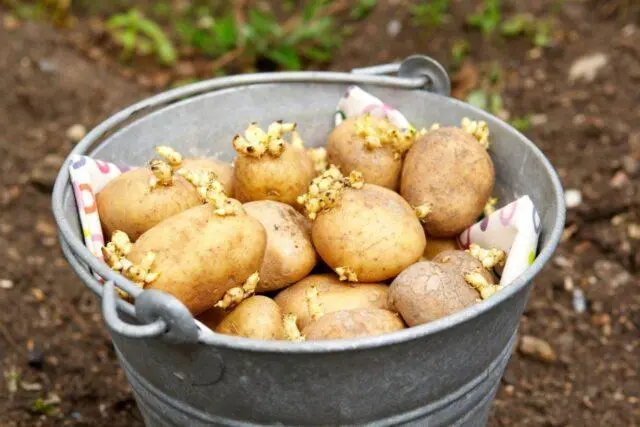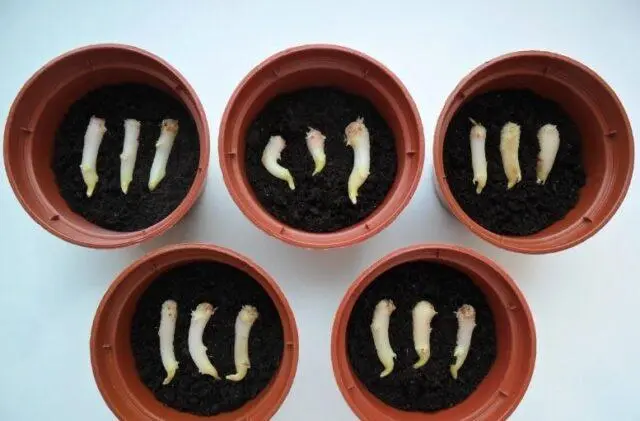Contents
Potatoes propagate primarily by tubers, although they can be propagated by layering, cuttings, seeds, and even skins with eyes. Each method has its own characteristics, pros and cons. Step-by-step instructions and practical growing tips can be found in this article.
How potatoes reproduce
Potatoes mainly reproduce vegetatively, i.e. without seeds. This allows for 100% transmission of genetic traits from one generation to another. As a rule, vegetative methods are quite simple. For example, it is enough to germinate tubers, and then plant them in open ground in May and harvest a full-fledged crop in July-August.
But there is also a generative way to propagate potatoes using seeds. In this case, it is possible to save in terms of money and space. Seeds take up significantly less space, they are easier to deliver and germinate. In addition, they hibernate even in matchboxes without creating special conditions. However, it is necessary to grow seedlings, which is more difficult than, for example, propagating potatoes with tops. In addition, genes can be combined in different ways, which is why it will not be possible to preserve all varietal characteristics.
That is why in practice most often potatoes are bred vegetatively. There are several available ways to do this, for example, growing from tubers, as well as propagation by eyes, sprouts and even peel. Step by step instructions for each method are provided below.
tubers
Growing potatoes from tubers is the most common method of propagation. They are sorted in advance, and a month before planting they are laid out in a lighted room with a temperature of 12-15 degrees Celsius. Then proceed as follows:
- Spread in two layers on the floor or in wooden boxes.
- Periodically sprayed from the sprayer, turn over.
- Several times they are treated with a growth stimulator, for example, “Epin” or “Zircon”.
- After two weeks, with this method of reproduction, sprouts will already appear. It is necessary to continue to spray with water and turn over.
- In early May, they are planted in pre-prepared holes according to the established pattern, for example, 70 cm between rows and 30 cm between adjacent tubers.
Classic seeds are not tubers, but grains that ripen in green berries. They are harvested by hand, stored until spring, and then seedlings are grown.

Thanks to spraying with water, potatoes can germinate in 2-3 weeks.
Propagation by sprouts
This method of reproduction is resorted to in cases where there is little planting material. The instruction is this:
- Germinate tubers in moist soil.
- As soon as the sprouts reach 6 cm, they are separated from the mother root crop.
- If there are few sprouts, they can be cut into several sections so that each has 1-2 buds.
- They are transferred to seedling boxes or individual pots, planted at 2/3 of the depth.
- Put in a lighted place, cover with a film, periodically water and ventilate.
- After 3-4 weeks, they are transplanted into open ground.
Thanks to this method, it is possible to receive several batches of seed material at once during the season. Potatoes are quite viable – after cutting off the old sprouts, new ones are formed in their place. Moreover, the efficiency is high, since each root crop can produce up to 40 sprouts. However, they are demanding on temperature, watering and other growing conditions. In addition, each sprout will give only 3-5 tubers. Another risk is associated with the possible transmission of a bacterial or fungal infection.
Eyes
Another vegetative way of propagating potatoes is with eyes. These are conical formations with a diameter of up to 2 cm, which can also give new layering. The instruction is as follows:
- Back in January-February, large tubers are selected and eyes are cut out of them (the rest is used for food).
- A month before the planned planting, in early April, the eyes are planted with cuts downwards in loose, fertile soil. You can use a seed box.
- The soil is treated with “Trichodermin” or another drug for the prevention of black leg.
- For successful reproduction, potato eyes are planted at 5 cm intervals (7 cm between rows).
- Sprinkle with soil up to 1 cm.
- Grow at a temperature of 16-20 degrees in a lit place, periodically watered.
- After the seedlings grow to 3 cm, they are again sprinkled with soil, then the procedure is repeated two more times.
- When the seedlings reach 10 cm, they can already be transplanted to the site.
peeled
Reproduction of potatoes is possible even with the help of the peel, if it has eyes. They are cut and dried a little, and then planted directly into the soil, and you need to place the eye up. Sprinkle with fertile soil and grow in the same way as regular potatoes. The harvest will turn out to be small, but then the variety can be bred in the traditional way using tubers.

Cleaning with eyes can be planted in pots, and then transferred to open ground
Layers
Potatoes are also propagated by layering. To do this, select high-quality tubers without cracks, mechanical damage and signs of disease. You need to act like this:
- A month before planting, put them in a lighted place, keep at a temperature of 15 degrees.
- Arrange in boxes with peat or loose soil at intervals of 2 cm to a depth of 5 cm.
- Periodically water with water at room temperature.
- Place the boxes in a greenhouse or next to a window – in such breeding conditions, potato seedlings will appear in just 7-10 days.
- When the sprouts reach 6-8 cm, they are simply separated from the parent root crop and planted in a permanent place.
- At the same time, the parent tubers can be sprinkled with soil again to get new layers.
This method of reproduction provides tangible advantages – you can get many plants at once, besides, even large tubers are suitable for growing (in this case, the size is unimportant). Although there are also disadvantages associated with the risks of infection and the complexity of the technology.

The main stages of reproduction by layering
Tuber division
Tuber division – this is not the same as the traditional cultivation of seed potatoes from root crops. With this method of reproduction, the eyes are involved. Usually 6-10 such formations appear on the root crop. But only the apical ones are well developed. If they are removed, the rest begin to grow, and then reproduction will be successful.
The sequence of actions is as follows:
- A month before planting, seed potatoes are transferred to a cool and lit room (temperature up to 15 degrees).
- Spread on the floor or in boxes, periodically sprayed with water.
- The next stage of potato propagation – three weeks after laying, the apical eyes are removed along with a small part of the pulp.
- They are placed in fertile soil for seedlings or wet sawdust to a depth of 1 cm.
- Water periodically.
- For successful propagation, cut potato tubers are placed in dry soil with the cut up and wait until the rest of the eyes begin to grow.
- A week later, the top along with the root is removed, divided into several parts.
- Each fragment is transplanted into open ground according to the chosen scheme.
This propagation method makes it possible to use the main part of potato tubers for food. Moreover, even large root crops can be used for breeding. If you remove the apical buds, the rest will begin to grow faster. Although there are disadvantages – the risk of contracting infections increases. In addition, each eye gives a maximum of five tubers.
Cutting
Another vegetative method of propagating potatoes is using cuttings. It is used in cases where the plants have faded, since at this moment it is no longer possible to get eyes or sprouts. The algorithm is this:
- After withering all the buds, several shoots are cut from the bushes from the side.
- The upper part is cut off from each and cuttings are obtained, which must have at least one leaf and a kidney in the bosom.
- Treat the sections with a solution of fungicide or potassium permanganate.
- For successful propagation, cuttings are planted in separate boxes with fertile soil. Moreover, the stem must necessarily lie horizontally, and the leaf must rise vertically.
- Cuttings should be sprinkled with soil only 1 cm, leaving all the leaves on the surface.
- Put the containers in a warm, well-lit place, moisten periodically.
- A month later, when small tubers appear, put them away for storage, and plant them in open ground the next season. Those. further reproduction of potatoes is carried out in the traditional way from tubers.

Potato cuttings begin after flowering is completed.
This breeding technology allows you to protect plants from fungal and bacterial infections (provided that the soil is clean). In addition, potatoes can be grown in a box, which is not so difficult. However, cuttings require good care – stable lighting and moisture. Moreover, each of them gives only one tuber. Therefore, it is possible to achieve good yields only for the next season.
Reproduction by seeds
Finally, potatoes can also be propagated from seeds. This is a rare method because it is labor intensive. Therefore, this technology is used only for very valuable, rare varieties. The sequence of actions is as follows:
- Collect seeds from green berries in summer.
- Dry them in a ventilated area or under a canopy.
- Store in matchboxes until March.
- In early spring, sow in boxes with fertile soil for seedlings.
- Put in a warm place, cover with foil and water periodically.
- 1,5 months after sowing, transfer the seedlings to the ground – then the propagation of potatoes is carried out in the traditional way.
Growing seedlings requires creating suitable conditions, regular watering, fertilizing and loosening the soil. But thanks to this method, it is possible to obtain a large amount of planting material and even breed a new variety.
Combination of potato propagation methods
As a rule, potatoes are bred from tubers. But you can also combine different methods of reproduction. Practice shows that this method can significantly increase the amount of planting material (8-10 times). The algorithm of actions is as follows:
- Tubers propagate by sprouts, cut them and plant them.
- Divide the root crop into several parts so that each has one eye. Plant in the ground.
- After the bushes reach 20 cm, divide them into several parts.
- After the end of the flowering phase, cut the plants.
Conclusion
Potatoes reproduce in many ways. Mostly summer residents and farmers use vegetative methods, as they give good results with minimal labor. Although in some cases potatoes are grown from seeds. Thanks to this, you can even get a new variety with a unique combination of properties.










Men 18 umumiy o’rta ta’lim maktabi biologiya o’qituvchisi bo’laman bu usullar juda qulay va samarali men ham oquvchilar bilan amali mashg’ulot olib bordim bunda kartoshkani har bir tugunagini olib suvli muhitda parvarish qildim novda bolgan paytda uni tuproqqa ekdim natija yaxshi boldi.